FIN700 Financial Management Group Assignment
VerifiedAdded on 2020/03/01
|17
|3268
|63
Homework Assignment
AI Summary
This assignment for FIN700 - Financial Management requires students to work in groups to solve four financial problems involving calculations and recommendations. The assignment emphasizes the importance of understanding financial concepts such as the time value of money, net present value (NPV), and internal rate of return (IRR). Students must adhere to specific formatting guidelines and submit their work by the due date. The assignment is designed to enhance collaborative learning and practical application of financial theories.
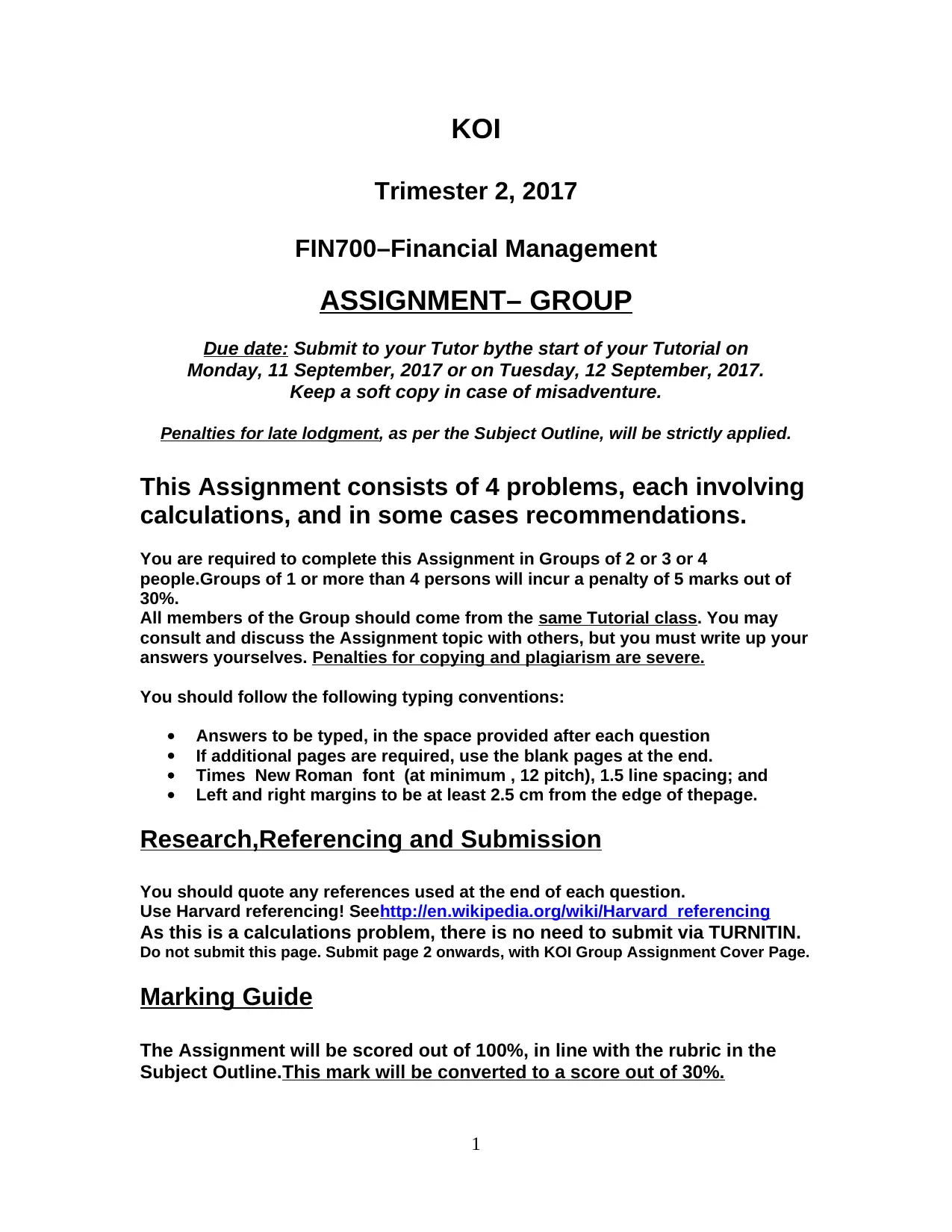
KOI
Trimester 2, 2017
FIN700–Financial Management
ASSIGNMENT– GROUP
Due date: Submit to your Tutor bythe start of your Tutorial on
Monday, 11 September, 2017 or on Tuesday, 12 September, 2017.
Keep a soft copy in case of misadventure.
Penalties for late lodgment, as per the Subject Outline, will be strictly applied.
This Assignment consists of 4 problems, each involving
calculations, and in some cases recommendations.
You are required to complete this Assignment in Groups of 2 or 3 or 4
people.Groups of 1 or more than 4 persons will incur a penalty of 5 marks out of
30%.
All members of the Group should come from the same Tutorial class. You may
consult and discuss the Assignment topic with others, but you must write up your
answers yourselves. Penalties for copying and plagiarism are severe.
You should follow the following typing conventions:
Answers to be typed, in the space provided after each question
If additional pages are required, use the blank pages at the end.
Times New Roman font (at minimum , 12 pitch), 1.5 line spacing; and
Left and right margins to be at least 2.5 cm from the edge of thepage.
Research,Referencing and Submission
You should quote any references used at the end of each question.
Use Harvard referencing! Seehttp://en.wikipedia.org/wiki/Harvard_referencing
As this is a calculations problem, there is no need to submit via TURNITIN.
Do not submit this page. Submit page 2 onwards, with KOI Group Assignment Cover Page.
Marking Guide
The Assignment will be scored out of 100%, in line with the rubric in the
Subject Outline.This mark will be converted to a score out of 30%.
1
Trimester 2, 2017
FIN700–Financial Management
ASSIGNMENT– GROUP
Due date: Submit to your Tutor bythe start of your Tutorial on
Monday, 11 September, 2017 or on Tuesday, 12 September, 2017.
Keep a soft copy in case of misadventure.
Penalties for late lodgment, as per the Subject Outline, will be strictly applied.
This Assignment consists of 4 problems, each involving
calculations, and in some cases recommendations.
You are required to complete this Assignment in Groups of 2 or 3 or 4
people.Groups of 1 or more than 4 persons will incur a penalty of 5 marks out of
30%.
All members of the Group should come from the same Tutorial class. You may
consult and discuss the Assignment topic with others, but you must write up your
answers yourselves. Penalties for copying and plagiarism are severe.
You should follow the following typing conventions:
Answers to be typed, in the space provided after each question
If additional pages are required, use the blank pages at the end.
Times New Roman font (at minimum , 12 pitch), 1.5 line spacing; and
Left and right margins to be at least 2.5 cm from the edge of thepage.
Research,Referencing and Submission
You should quote any references used at the end of each question.
Use Harvard referencing! Seehttp://en.wikipedia.org/wiki/Harvard_referencing
As this is a calculations problem, there is no need to submit via TURNITIN.
Do not submit this page. Submit page 2 onwards, with KOI Group Assignment Cover Page.
Marking Guide
The Assignment will be scored out of 100%, in line with the rubric in the
Subject Outline.This mark will be converted to a score out of 30%.
1
Paraphrase This Document
Need a fresh take? Get an instant paraphrase of this document with our AI Paraphraser
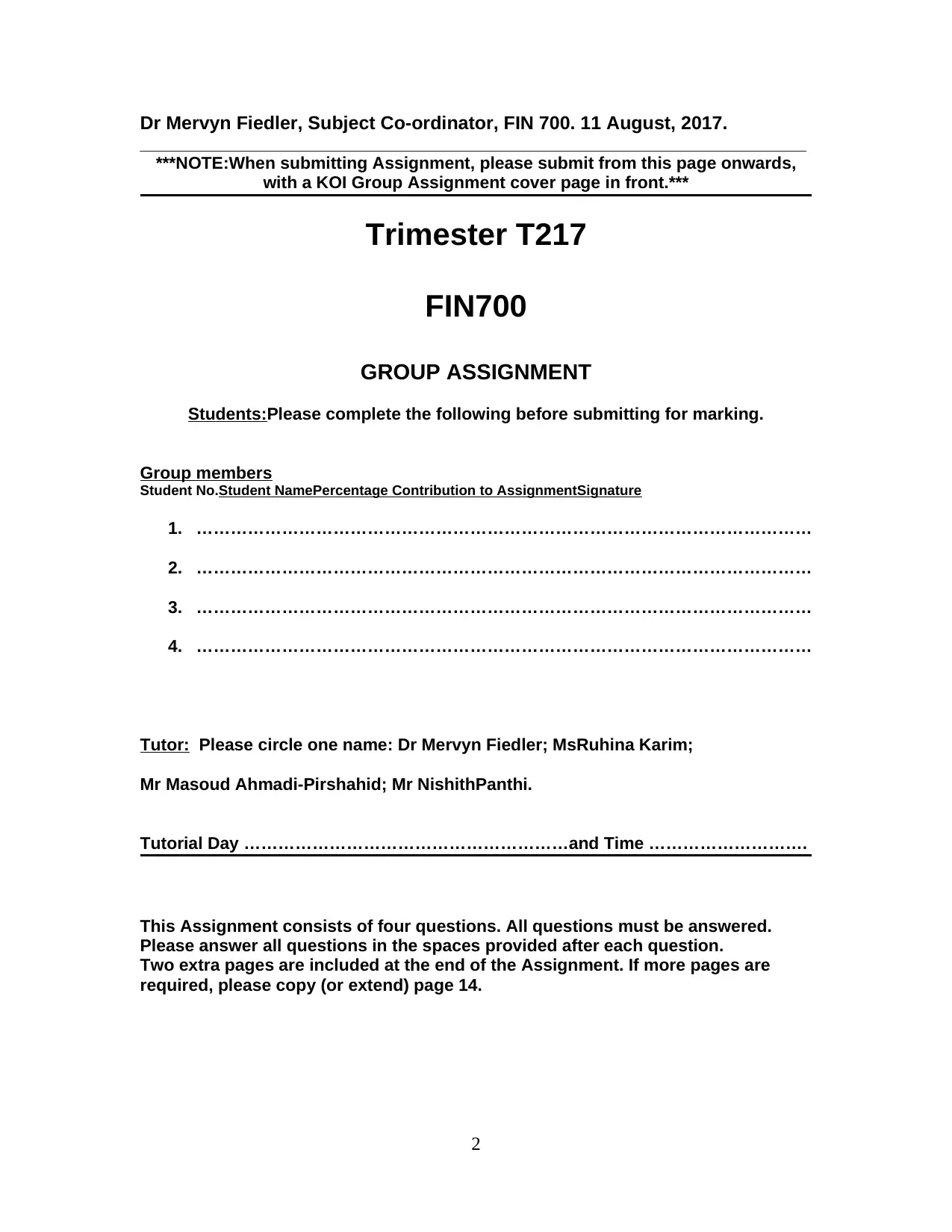
Dr Mervyn Fiedler, Subject Co-ordinator, FIN 700. 11 August, 2017.
______________________________________________________________________
***NOTE:When submitting Assignment, please submit from this page onwards,
with a KOI Group Assignment cover page in front.***
Trimester T217
FIN700
GROUP ASSIGNMENT
Students:Please complete the following before submitting for marking.
Group members
Student No.Student NamePercentage Contribution to AssignmentSignature
1. ………………………………………………………………………………………………
2. ………………………………………………………………………………………………
3. ………………………………………………………………………………………………
4. ………………………………………………………………………………………………
Tutor: Please circle one name: Dr Mervyn Fiedler; MsRuhina Karim;
Mr Masoud Ahmadi-Pirshahid; Mr NishithPanthi.
Tutorial Day …………………………………………………and Time ……………………….
This Assignment consists of four questions. All questions must be answered.
Please answer all questions in the spaces provided after each question.
Two extra pages are included at the end of the Assignment. If more pages are
required, please copy (or extend) page 14.
2
______________________________________________________________________
***NOTE:When submitting Assignment, please submit from this page onwards,
with a KOI Group Assignment cover page in front.***
Trimester T217
FIN700
GROUP ASSIGNMENT
Students:Please complete the following before submitting for marking.
Group members
Student No.Student NamePercentage Contribution to AssignmentSignature
1. ………………………………………………………………………………………………
2. ………………………………………………………………………………………………
3. ………………………………………………………………………………………………
4. ………………………………………………………………………………………………
Tutor: Please circle one name: Dr Mervyn Fiedler; MsRuhina Karim;
Mr Masoud Ahmadi-Pirshahid; Mr NishithPanthi.
Tutorial Day …………………………………………………and Time ……………………….
This Assignment consists of four questions. All questions must be answered.
Please answer all questions in the spaces provided after each question.
Two extra pages are included at the end of the Assignment. If more pages are
required, please copy (or extend) page 14.
2
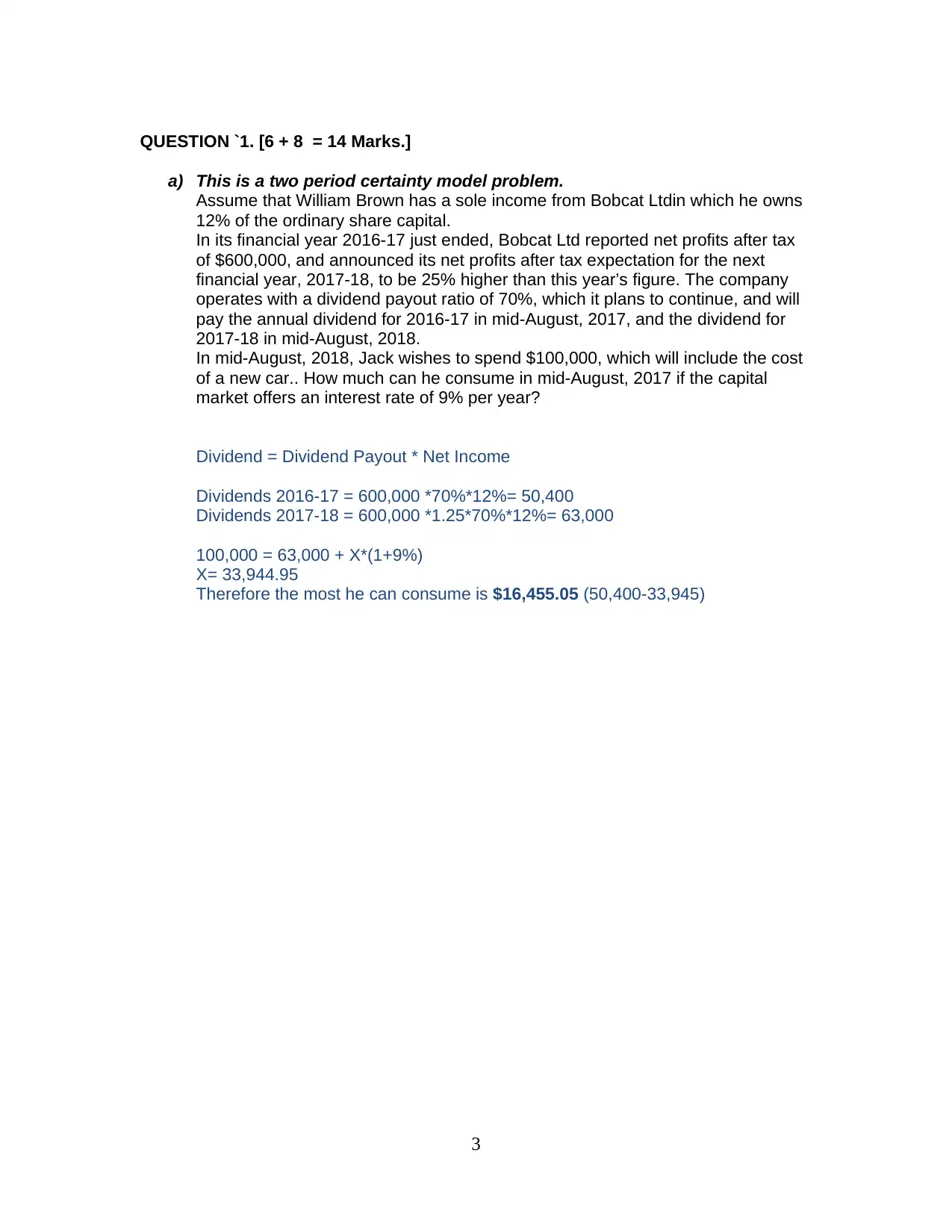
QUESTION `1. [6 + 8 = 14 Marks.]
a) This is a two period certainty model problem.
Assume that William Brown has a sole income from Bobcat Ltdin which he owns
12% of the ordinary share capital.
In its financial year 2016-17 just ended, Bobcat Ltd reported net profits after tax
of $600,000, and announced its net profits after tax expectation for the next
financial year, 2017-18, to be 25% higher than this year’s figure. The company
operates with a dividend payout ratio of 70%, which it plans to continue, and will
pay the annual dividend for 2016-17 in mid-August, 2017, and the dividend for
2017-18 in mid-August, 2018.
In mid-August, 2018, Jack wishes to spend $100,000, which will include the cost
of a new car.. How much can he consume in mid-August, 2017 if the capital
market offers an interest rate of 9% per year?
Dividend = Dividend Payout * Net Income
Dividends 2016-17 = 600,000 *70%*12%= 50,400
Dividends 2017-18 = 600,000 *1.25*70%*12%= 63,000
100,000 = 63,000 + X*(1+9%)
X= 33,944.95
Therefore the most he can consume is $16,455.05 (50,400-33,945)
3
a) This is a two period certainty model problem.
Assume that William Brown has a sole income from Bobcat Ltdin which he owns
12% of the ordinary share capital.
In its financial year 2016-17 just ended, Bobcat Ltd reported net profits after tax
of $600,000, and announced its net profits after tax expectation for the next
financial year, 2017-18, to be 25% higher than this year’s figure. The company
operates with a dividend payout ratio of 70%, which it plans to continue, and will
pay the annual dividend for 2016-17 in mid-August, 2017, and the dividend for
2017-18 in mid-August, 2018.
In mid-August, 2018, Jack wishes to spend $100,000, which will include the cost
of a new car.. How much can he consume in mid-August, 2017 if the capital
market offers an interest rate of 9% per year?
Dividend = Dividend Payout * Net Income
Dividends 2016-17 = 600,000 *70%*12%= 50,400
Dividends 2017-18 = 600,000 *1.25*70%*12%= 63,000
100,000 = 63,000 + X*(1+9%)
X= 33,944.95
Therefore the most he can consume is $16,455.05 (50,400-33,945)
3
⊘ This is a preview!⊘
Do you want full access?
Subscribe today to unlock all pages.

Trusted by 1+ million students worldwide
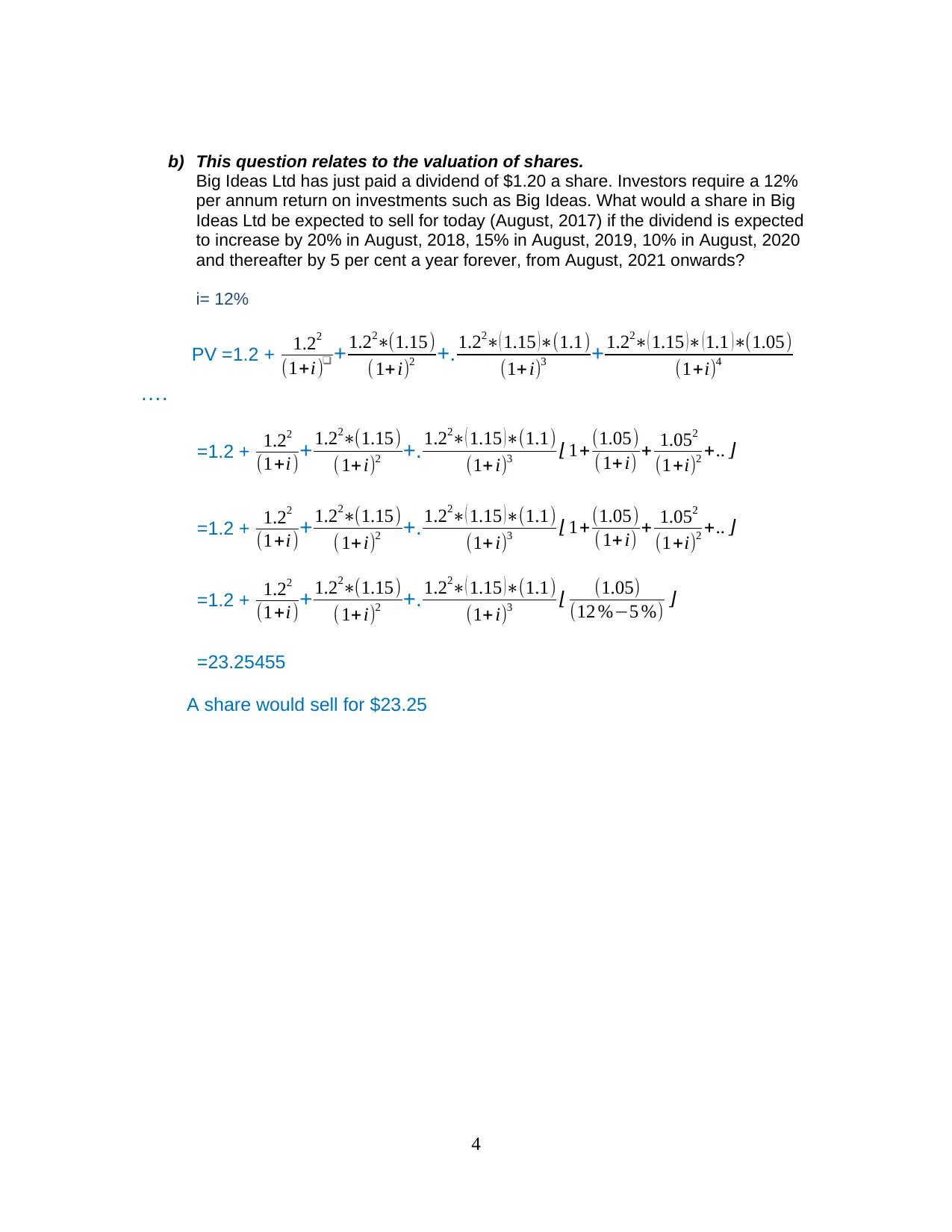
b) This question relates to the valuation of shares.
Big Ideas Ltd has just paid a dividend of $1.20 a share. Investors require a 12%
per annum return on investments such as Big Ideas. What would a share in Big
Ideas Ltd be expected to sell for today (August, 2017) if the dividend is expected
to increase by 20% in August, 2018, 15% in August, 2019, 10% in August, 2020
and thereafter by 5 per cent a year forever, from August, 2021 onwards?
i= 12%
PV =1.2 + 1.22
(1+i)❑ + 1.22∗(1.15)
(1+i)2 +.1.22∗( 1.15 )∗(1.1)
(1+ i)3 + 1.22∗( 1.15 )∗ (1.1 )∗(1.05)
(1+i)4
….
=1.2 + 1.22
(1+i)+ 1.22∗(1.15)
(1+ i)2 +. 1.22∗( 1.15 )∗(1.1)
(1+ i)3 ⌊ 1+ (1.05)
( 1+ i) + 1.052
(1+i)2 +.. ⌋
=1.2 + 1.22
(1+i)+ 1.22∗(1.15)
(1+ i)2 +. 1.22∗( 1.15 )∗(1.1)
(1+ i)3 ⌊ 1+ (1.05)
( 1+ i) + 1.052
(1+i)2 +.. ⌋
=1.2 + 1.22
(1+i)+ 1.22∗(1.15)
(1+ i)2 +. 1.22∗( 1.15 )∗(1.1)
(1+ i)3 ⌊ (1.05)
(12 %−5 %) ⌋
=23.25455
A share would sell for $23.25
4
Big Ideas Ltd has just paid a dividend of $1.20 a share. Investors require a 12%
per annum return on investments such as Big Ideas. What would a share in Big
Ideas Ltd be expected to sell for today (August, 2017) if the dividend is expected
to increase by 20% in August, 2018, 15% in August, 2019, 10% in August, 2020
and thereafter by 5 per cent a year forever, from August, 2021 onwards?
i= 12%
PV =1.2 + 1.22
(1+i)❑ + 1.22∗(1.15)
(1+i)2 +.1.22∗( 1.15 )∗(1.1)
(1+ i)3 + 1.22∗( 1.15 )∗ (1.1 )∗(1.05)
(1+i)4
….
=1.2 + 1.22
(1+i)+ 1.22∗(1.15)
(1+ i)2 +. 1.22∗( 1.15 )∗(1.1)
(1+ i)3 ⌊ 1+ (1.05)
( 1+ i) + 1.052
(1+i)2 +.. ⌋
=1.2 + 1.22
(1+i)+ 1.22∗(1.15)
(1+ i)2 +. 1.22∗( 1.15 )∗(1.1)
(1+ i)3 ⌊ 1+ (1.05)
( 1+ i) + 1.052
(1+i)2 +.. ⌋
=1.2 + 1.22
(1+i)+ 1.22∗(1.15)
(1+ i)2 +. 1.22∗( 1.15 )∗(1.1)
(1+ i)3 ⌊ (1.05)
(12 %−5 %) ⌋
=23.25455
A share would sell for $23.25
4
Paraphrase This Document
Need a fresh take? Get an instant paraphrase of this document with our AI Paraphraser
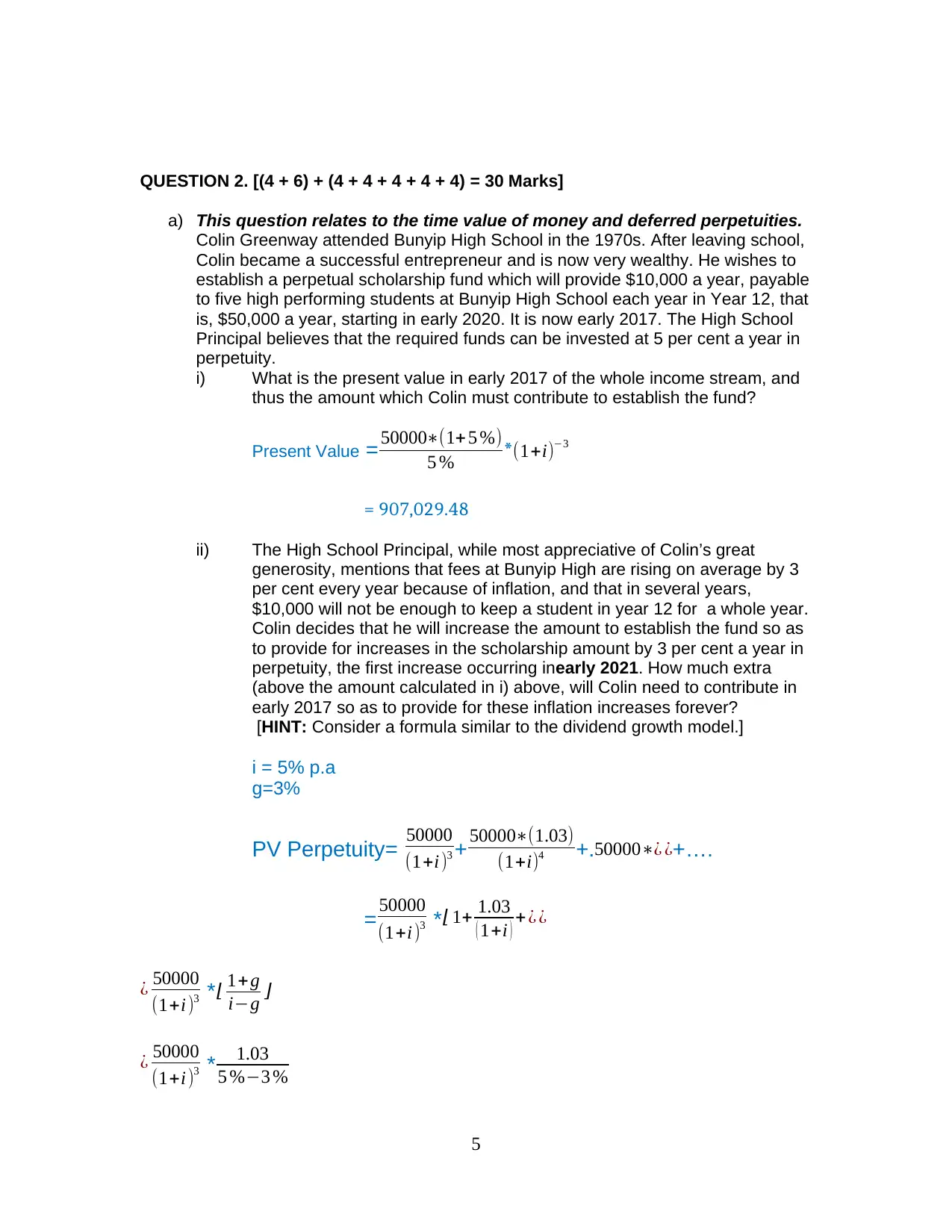
QUESTION 2. [(4 + 6) + (4 + 4 + 4 + 4 + 4) = 30 Marks]
a) This question relates to the time value of money and deferred perpetuities.
Colin Greenway attended Bunyip High School in the 1970s. After leaving school,
Colin became a successful entrepreneur and is now very wealthy. He wishes to
establish a perpetual scholarship fund which will provide $10,000 a year, payable
to five high performing students at Bunyip High School each year in Year 12, that
is, $50,000 a year, starting in early 2020. It is now early 2017. The High School
Principal believes that the required funds can be invested at 5 per cent a year in
perpetuity.
i) What is the present value in early 2017 of the whole income stream, and
thus the amount which Colin must contribute to establish the fund?
Present Value = 50000∗(1+ 5 %)
5 % *(1+i)−3
= 907,029.48
ii) The High School Principal, while most appreciative of Colin’s great
generosity, mentions that fees at Bunyip High are rising on average by 3
per cent every year because of inflation, and that in several years,
$10,000 will not be enough to keep a student in year 12 for a whole year.
Colin decides that he will increase the amount to establish the fund so as
to provide for increases in the scholarship amount by 3 per cent a year in
perpetuity, the first increase occurring inearly 2021. How much extra
(above the amount calculated in i) above, will Colin need to contribute in
early 2017 so as to provide for these inflation increases forever?
[HINT: Consider a formula similar to the dividend growth model.]
i = 5% p.a
g=3%
PV Perpetuity= 50000
(1+i )3 + 50000∗(1.03)
(1+i)4 +.50000∗¿ ¿+….
= 50000
(1+i)3 *⌊ 1+ 1.03
( 1+i ) +¿ ¿
¿ 50000
(1+i )3 *⌊ 1+ g
i−g ⌋
¿ 50000
(1+i )3 * 1.03
5 %−3 %
5
a) This question relates to the time value of money and deferred perpetuities.
Colin Greenway attended Bunyip High School in the 1970s. After leaving school,
Colin became a successful entrepreneur and is now very wealthy. He wishes to
establish a perpetual scholarship fund which will provide $10,000 a year, payable
to five high performing students at Bunyip High School each year in Year 12, that
is, $50,000 a year, starting in early 2020. It is now early 2017. The High School
Principal believes that the required funds can be invested at 5 per cent a year in
perpetuity.
i) What is the present value in early 2017 of the whole income stream, and
thus the amount which Colin must contribute to establish the fund?
Present Value = 50000∗(1+ 5 %)
5 % *(1+i)−3
= 907,029.48
ii) The High School Principal, while most appreciative of Colin’s great
generosity, mentions that fees at Bunyip High are rising on average by 3
per cent every year because of inflation, and that in several years,
$10,000 will not be enough to keep a student in year 12 for a whole year.
Colin decides that he will increase the amount to establish the fund so as
to provide for increases in the scholarship amount by 3 per cent a year in
perpetuity, the first increase occurring inearly 2021. How much extra
(above the amount calculated in i) above, will Colin need to contribute in
early 2017 so as to provide for these inflation increases forever?
[HINT: Consider a formula similar to the dividend growth model.]
i = 5% p.a
g=3%
PV Perpetuity= 50000
(1+i )3 + 50000∗(1.03)
(1+i)4 +.50000∗¿ ¿+….
= 50000
(1+i)3 *⌊ 1+ 1.03
( 1+i ) +¿ ¿
¿ 50000
(1+i )3 *⌊ 1+ g
i−g ⌋
¿ 50000
(1+i )3 * 1.03
5 %−3 %
5
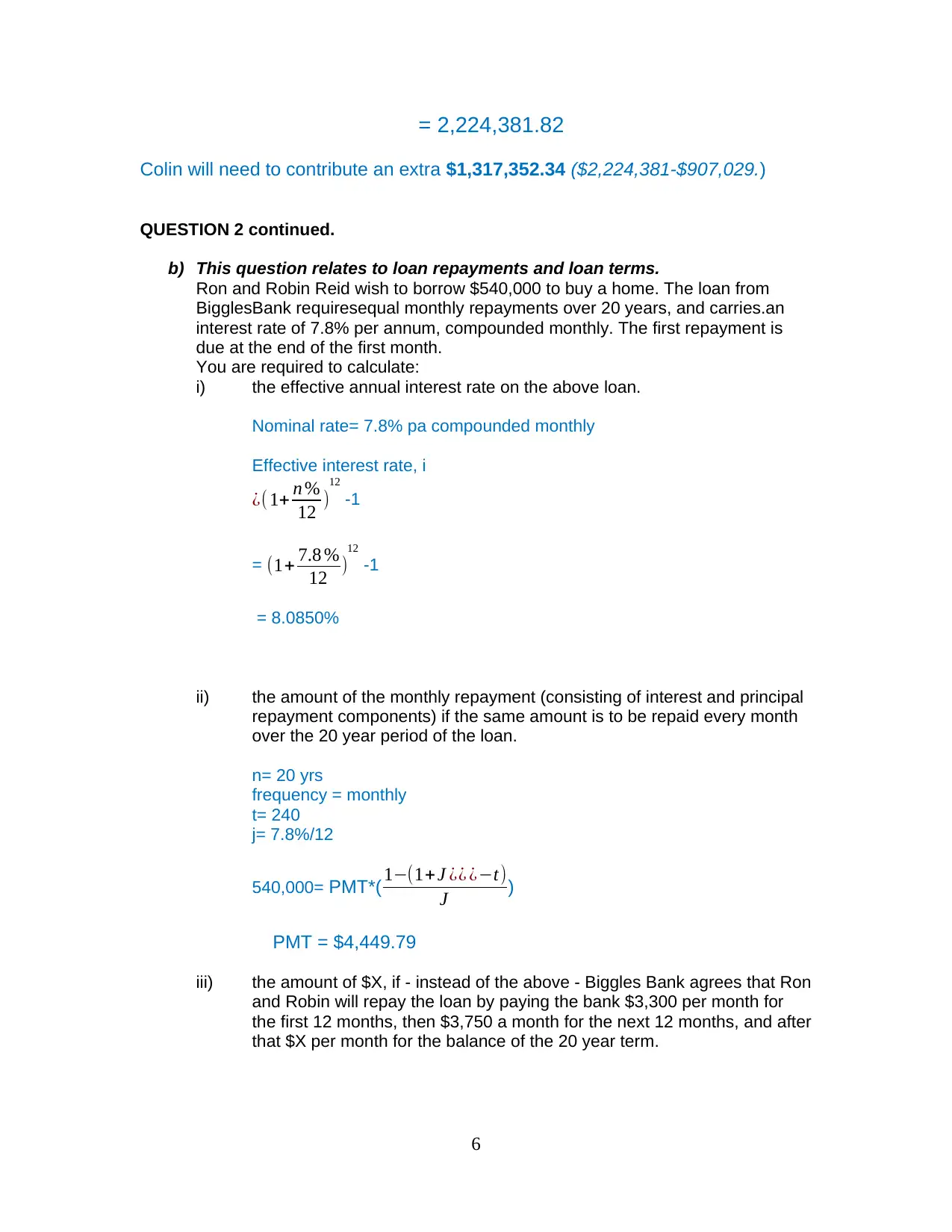
= 2,224,381.82
Colin will need to contribute an extra $1,317,352.34 ($2,224,381-$907,029.)
QUESTION 2 continued.
b) This question relates to loan repayments and loan terms.
Ron and Robin Reid wish to borrow $540,000 to buy a home. The loan from
BigglesBank requiresequal monthly repayments over 20 years, and carries.an
interest rate of 7.8% per annum, compounded monthly. The first repayment is
due at the end of the first month.
You are required to calculate:
i) the effective annual interest rate on the above loan.
Nominal rate= 7.8% pa compounded monthly
Effective interest rate, i
¿( 1+ n %
12 )
12
-1
= (1+ 7.8 %
12 )
12
-1
= 8.0850%
ii) the amount of the monthly repayment (consisting of interest and principal
repayment components) if the same amount is to be repaid every month
over the 20 year period of the loan.
n= 20 yrs
frequency = monthly
t= 240
j= 7.8%/12
540,000= PMT*( 1−(1+J ¿¿ ¿−t)
J )
PMT = $4,449.79
iii) the amount of $X, if - instead of the above - Biggles Bank agrees that Ron
and Robin will repay the loan by paying the bank $3,300 per month for
the first 12 months, then $3,750 a month for the next 12 months, and after
that $X per month for the balance of the 20 year term.
6
Colin will need to contribute an extra $1,317,352.34 ($2,224,381-$907,029.)
QUESTION 2 continued.
b) This question relates to loan repayments and loan terms.
Ron and Robin Reid wish to borrow $540,000 to buy a home. The loan from
BigglesBank requiresequal monthly repayments over 20 years, and carries.an
interest rate of 7.8% per annum, compounded monthly. The first repayment is
due at the end of the first month.
You are required to calculate:
i) the effective annual interest rate on the above loan.
Nominal rate= 7.8% pa compounded monthly
Effective interest rate, i
¿( 1+ n %
12 )
12
-1
= (1+ 7.8 %
12 )
12
-1
= 8.0850%
ii) the amount of the monthly repayment (consisting of interest and principal
repayment components) if the same amount is to be repaid every month
over the 20 year period of the loan.
n= 20 yrs
frequency = monthly
t= 240
j= 7.8%/12
540,000= PMT*( 1−(1+J ¿¿ ¿−t)
J )
PMT = $4,449.79
iii) the amount of $X, if - instead of the above - Biggles Bank agrees that Ron
and Robin will repay the loan by paying the bank $3,300 per month for
the first 12 months, then $3,750 a month for the next 12 months, and after
that $X per month for the balance of the 20 year term.
6
⊘ This is a preview!⊘
Do you want full access?
Subscribe today to unlock all pages.

Trusted by 1+ million students worldwide
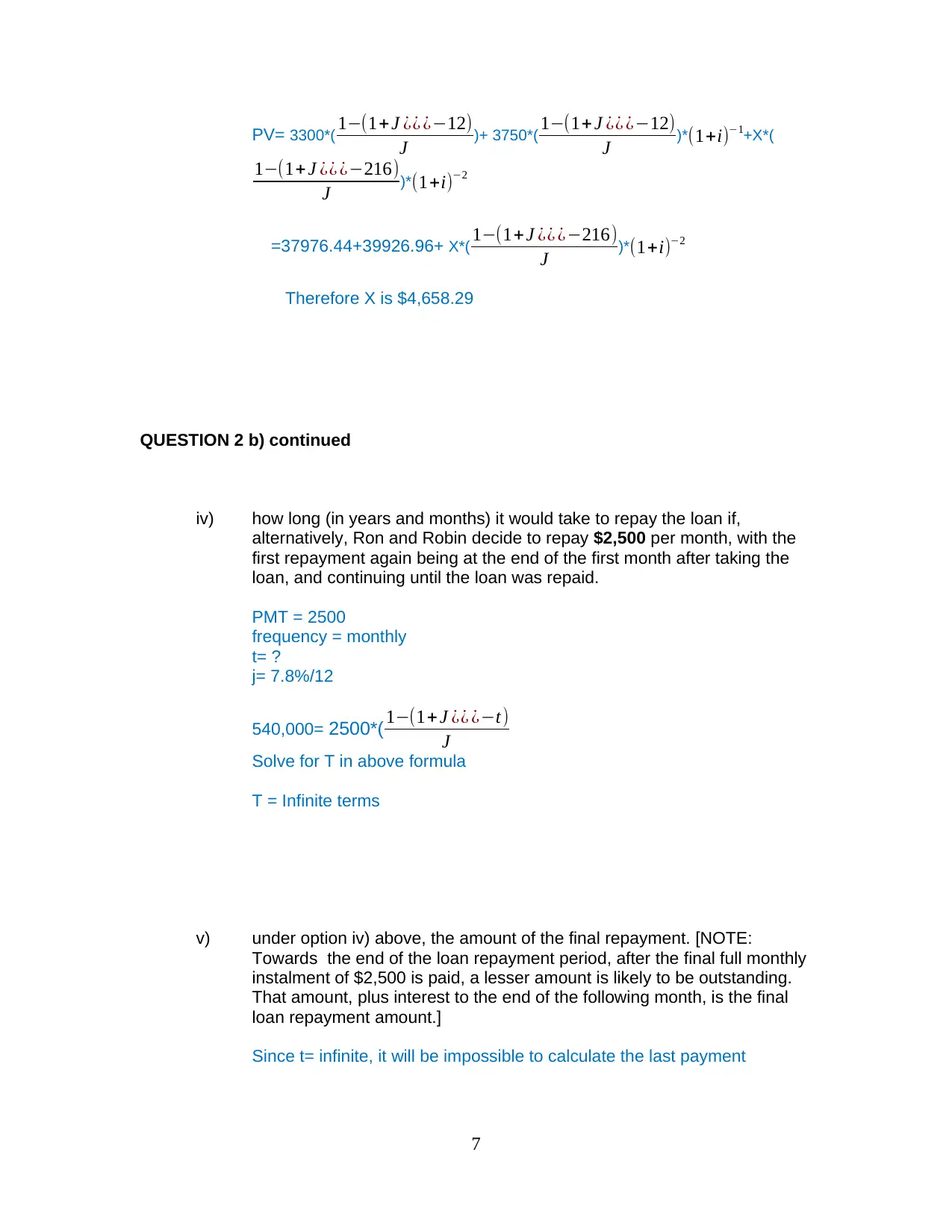
PV= 3300*( 1−(1+J ¿¿ ¿−12)
J )+ 3750*( 1−(1+ J ¿¿ ¿−12)
J )* (1+i)−1+X*(
1−(1+J ¿¿ ¿−216)
J )*(1+i)−2
=37976.44+39926.96+ X*( 1−(1+J ¿¿ ¿−216)
J )*(1+i)−2
Therefore X is $4,658.29
QUESTION 2 b) continued
iv) how long (in years and months) it would take to repay the loan if,
alternatively, Ron and Robin decide to repay $2,500 per month, with the
first repayment again being at the end of the first month after taking the
loan, and continuing until the loan was repaid.
PMT = 2500
frequency = monthly
t= ?
j= 7.8%/12
540,000= 2500*( 1−(1+ J ¿¿ ¿−t)
J
Solve for T in above formula
T = Infinite terms
v) under option iv) above, the amount of the final repayment. [NOTE:
Towards the end of the loan repayment period, after the final full monthly
instalment of $2,500 is paid, a lesser amount is likely to be outstanding.
That amount, plus interest to the end of the following month, is the final
loan repayment amount.]
Since t= infinite, it will be impossible to calculate the last payment
7
J )+ 3750*( 1−(1+ J ¿¿ ¿−12)
J )* (1+i)−1+X*(
1−(1+J ¿¿ ¿−216)
J )*(1+i)−2
=37976.44+39926.96+ X*( 1−(1+J ¿¿ ¿−216)
J )*(1+i)−2
Therefore X is $4,658.29
QUESTION 2 b) continued
iv) how long (in years and months) it would take to repay the loan if,
alternatively, Ron and Robin decide to repay $2,500 per month, with the
first repayment again being at the end of the first month after taking the
loan, and continuing until the loan was repaid.
PMT = 2500
frequency = monthly
t= ?
j= 7.8%/12
540,000= 2500*( 1−(1+ J ¿¿ ¿−t)
J
Solve for T in above formula
T = Infinite terms
v) under option iv) above, the amount of the final repayment. [NOTE:
Towards the end of the loan repayment period, after the final full monthly
instalment of $2,500 is paid, a lesser amount is likely to be outstanding.
That amount, plus interest to the end of the following month, is the final
loan repayment amount.]
Since t= infinite, it will be impossible to calculate the last payment
7
Paraphrase This Document
Need a fresh take? Get an instant paraphrase of this document with our AI Paraphraser
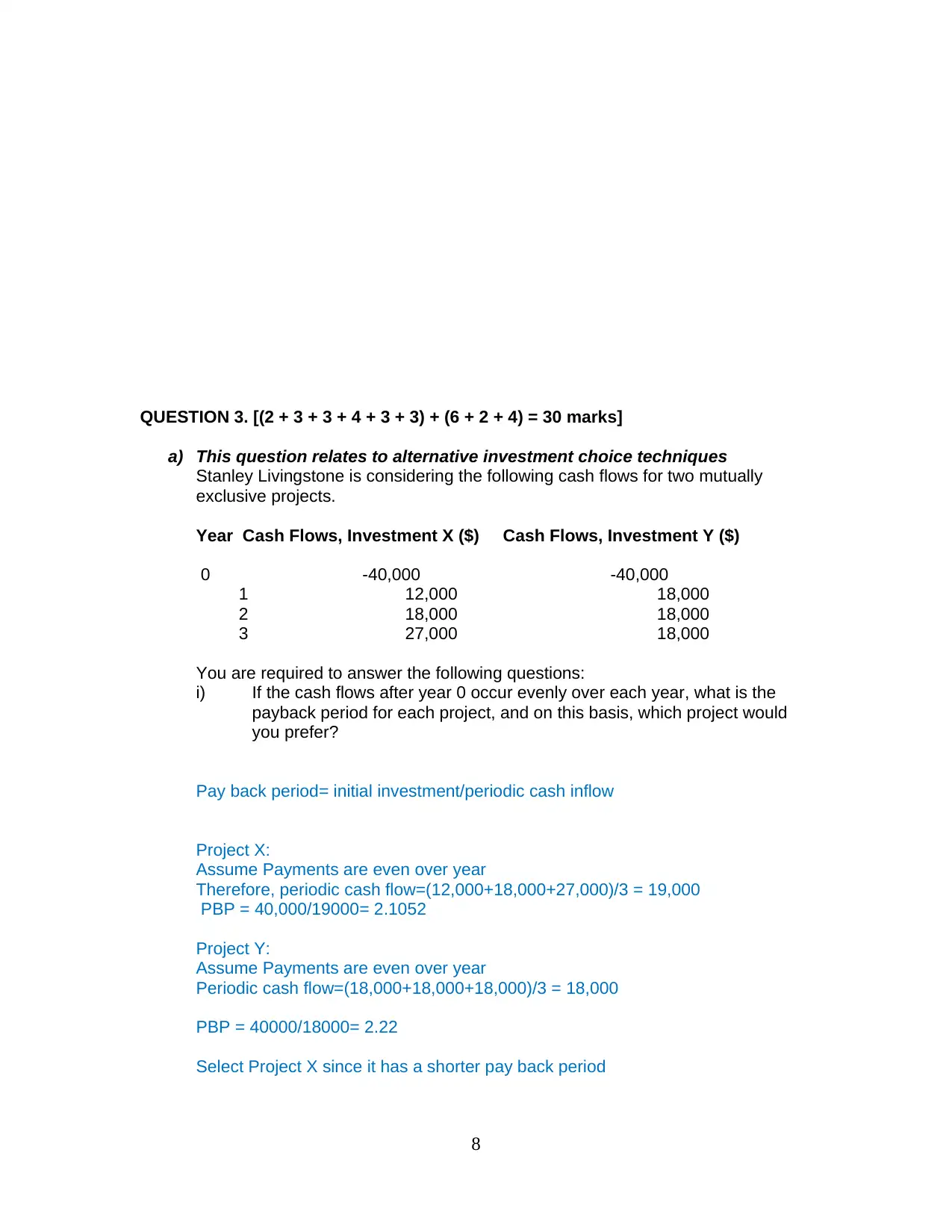
QUESTION 3. [(2 + 3 + 3 + 4 + 3 + 3) + (6 + 2 + 4) = 30 marks]
a) This question relates to alternative investment choice techniques
Stanley Livingstone is considering the following cash flows for two mutually
exclusive projects.
Year Cash Flows, Investment X ($) Cash Flows, Investment Y ($)
0 -40,000 -40,000
1 12,000 18,000
2 18,000 18,000
3 27,000 18,000
You are required to answer the following questions:
i) If the cash flows after year 0 occur evenly over each year, what is the
payback period for each project, and on this basis, which project would
you prefer?
Pay back period= initial investment/periodic cash inflow
Project X:
Assume Payments are even over year
Therefore, periodic cash flow=(12,000+18,000+27,000)/3 = 19,000
PBP = 40,000/19000= 2.1052
Project Y:
Assume Payments are even over year
Periodic cash flow=(18,000+18,000+18,000)/3 = 18,000
PBP = 40000/18000= 2.22
Select Project X since it has a shorter pay back period
8
a) This question relates to alternative investment choice techniques
Stanley Livingstone is considering the following cash flows for two mutually
exclusive projects.
Year Cash Flows, Investment X ($) Cash Flows, Investment Y ($)
0 -40,000 -40,000
1 12,000 18,000
2 18,000 18,000
3 27,000 18,000
You are required to answer the following questions:
i) If the cash flows after year 0 occur evenly over each year, what is the
payback period for each project, and on this basis, which project would
you prefer?
Pay back period= initial investment/periodic cash inflow
Project X:
Assume Payments are even over year
Therefore, periodic cash flow=(12,000+18,000+27,000)/3 = 19,000
PBP = 40,000/19000= 2.1052
Project Y:
Assume Payments are even over year
Periodic cash flow=(18,000+18,000+18,000)/3 = 18,000
PBP = 40000/18000= 2.22
Select Project X since it has a shorter pay back period
8
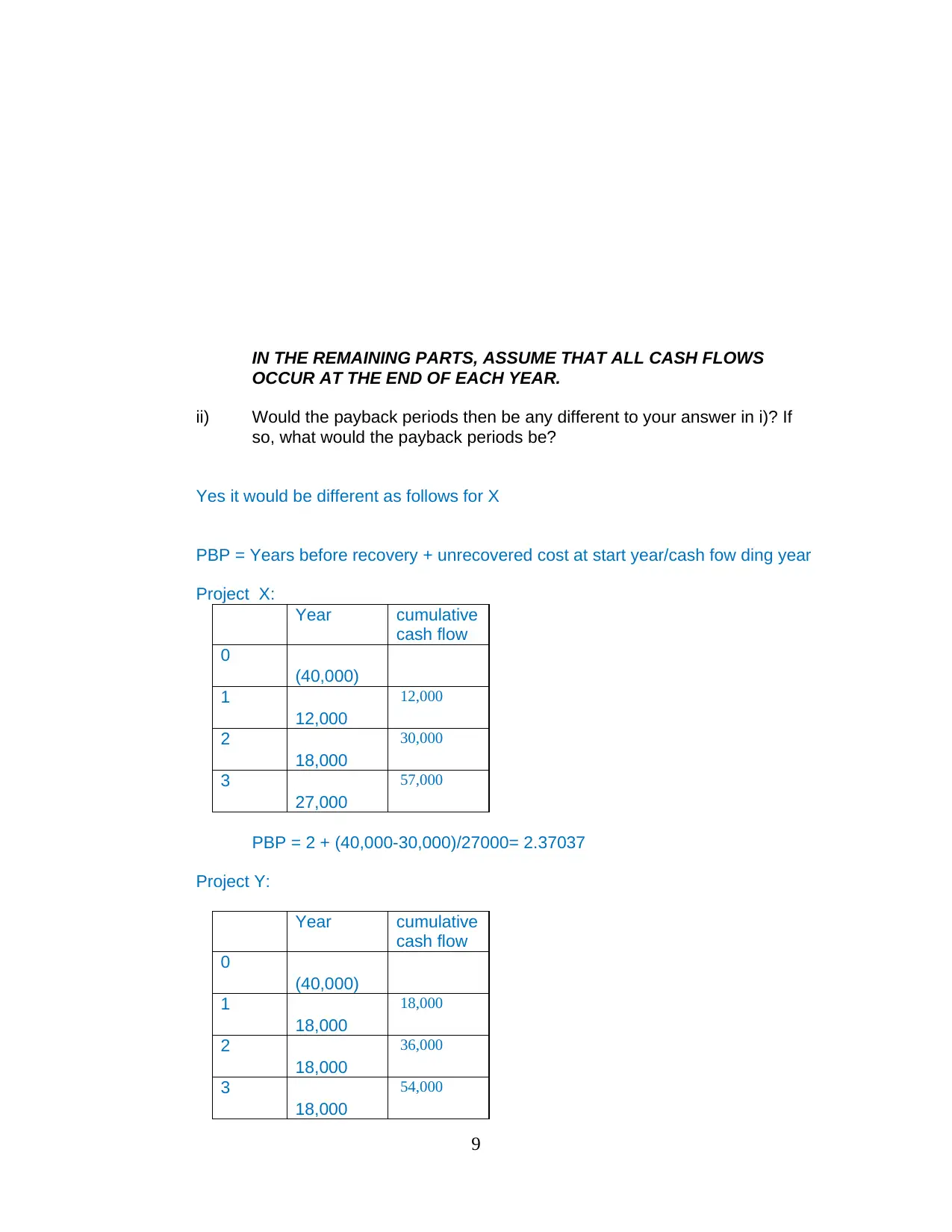
IN THE REMAINING PARTS, ASSUME THAT ALL CASH FLOWS
OCCUR AT THE END OF EACH YEAR.
ii) Would the payback periods then be any different to your answer in i)? If
so, what would the payback periods be?
Yes it would be different as follows for X
PBP = Years before recovery + unrecovered cost at start year/cash fow ding year
Project X:
Year cumulative
cash flow
0
(40,000)
1
12,000
12,000
2
18,000
30,000
3
27,000
57,000
PBP = 2 + (40,000-30,000)/27000= 2.37037
Project Y:
Year cumulative
cash flow
0
(40,000)
1
18,000
18,000
2
18,000
36,000
3
18,000
54,000
9
OCCUR AT THE END OF EACH YEAR.
ii) Would the payback periods then be any different to your answer in i)? If
so, what would the payback periods be?
Yes it would be different as follows for X
PBP = Years before recovery + unrecovered cost at start year/cash fow ding year
Project X:
Year cumulative
cash flow
0
(40,000)
1
12,000
12,000
2
18,000
30,000
3
27,000
57,000
PBP = 2 + (40,000-30,000)/27000= 2.37037
Project Y:
Year cumulative
cash flow
0
(40,000)
1
18,000
18,000
2
18,000
36,000
3
18,000
54,000
9
⊘ This is a preview!⊘
Do you want full access?
Subscribe today to unlock all pages.

Trusted by 1+ million students worldwide
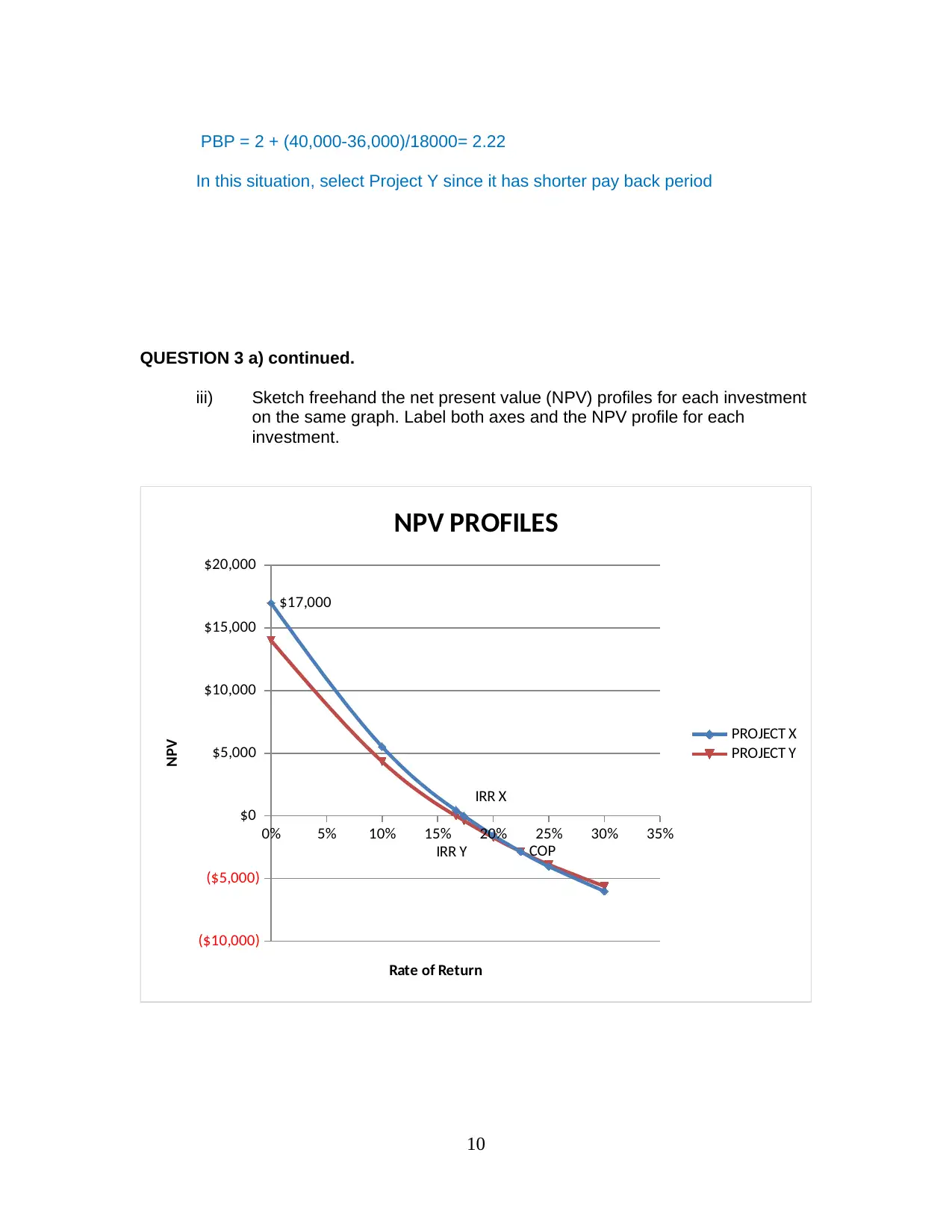
PBP = 2 + (40,000-36,000)/18000= 2.22
In this situation, select Project Y since it has shorter pay back period
QUESTION 3 a) continued.
iii) Sketch freehand the net present value (NPV) profiles for each investment
on the same graph. Label both axes and the NPV profile for each
investment.
0% 5% 10% 15% 20% 25% 30% 35%
($10,000)
($5,000)
$0
$5,000
$10,000
$15,000
$20,000
IRR Y COP
$17,000
IRR X
NPV PROFILES
PROJECT X
PROJECT Y
Rate of Return
NPV
10
In this situation, select Project Y since it has shorter pay back period
QUESTION 3 a) continued.
iii) Sketch freehand the net present value (NPV) profiles for each investment
on the same graph. Label both axes and the NPV profile for each
investment.
0% 5% 10% 15% 20% 25% 30% 35%
($10,000)
($5,000)
$0
$5,000
$10,000
$15,000
$20,000
IRR Y COP
$17,000
IRR X
NPV PROFILES
PROJECT X
PROJECT Y
Rate of Return
NPV
10
Paraphrase This Document
Need a fresh take? Get an instant paraphrase of this document with our AI Paraphraser
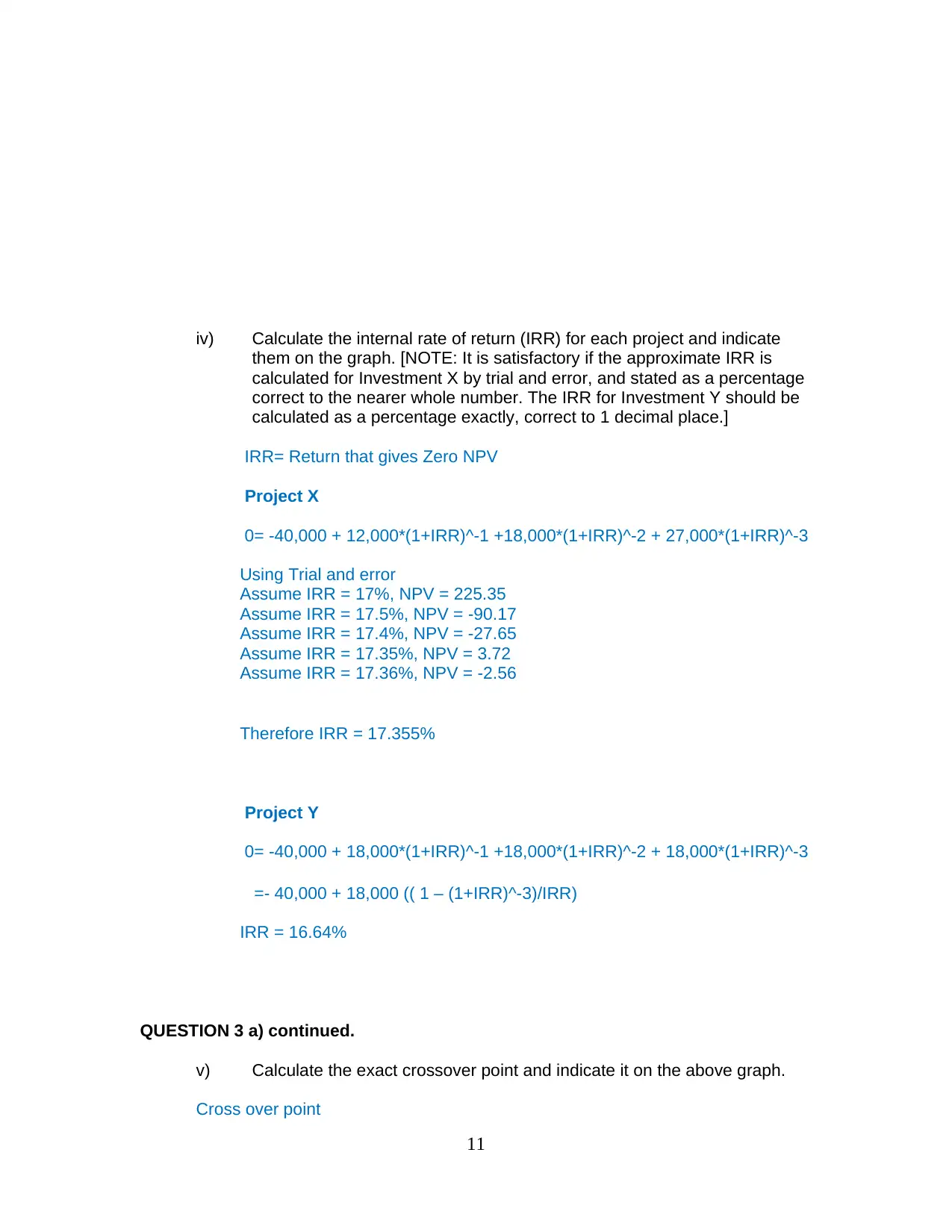
iv) Calculate the internal rate of return (IRR) for each project and indicate
them on the graph. [NOTE: It is satisfactory if the approximate IRR is
calculated for Investment X by trial and error, and stated as a percentage
correct to the nearer whole number. The IRR for Investment Y should be
calculated as a percentage exactly, correct to 1 decimal place.]
IRR= Return that gives Zero NPV
Project X
0= -40,000 + 12,000*(1+IRR)^-1 +18,000*(1+IRR)^-2 + 27,000*(1+IRR)^-3
Using Trial and error
Assume IRR = 17%, NPV = 225.35
Assume IRR = 17.5%, NPV = -90.17
Assume IRR = 17.4%, NPV = -27.65
Assume IRR = 17.35%, NPV = 3.72
Assume IRR = 17.36%, NPV = -2.56
Therefore IRR = 17.355%
Project Y
0= -40,000 + 18,000*(1+IRR)^-1 +18,000*(1+IRR)^-2 + 18,000*(1+IRR)^-3
=- 40,000 + 18,000 (( 1 – (1+IRR)^-3)/IRR)
IRR = 16.64%
QUESTION 3 a) continued.
v) Calculate the exact crossover point and indicate it on the above graph.
Cross over point
11
them on the graph. [NOTE: It is satisfactory if the approximate IRR is
calculated for Investment X by trial and error, and stated as a percentage
correct to the nearer whole number. The IRR for Investment Y should be
calculated as a percentage exactly, correct to 1 decimal place.]
IRR= Return that gives Zero NPV
Project X
0= -40,000 + 12,000*(1+IRR)^-1 +18,000*(1+IRR)^-2 + 27,000*(1+IRR)^-3
Using Trial and error
Assume IRR = 17%, NPV = 225.35
Assume IRR = 17.5%, NPV = -90.17
Assume IRR = 17.4%, NPV = -27.65
Assume IRR = 17.35%, NPV = 3.72
Assume IRR = 17.36%, NPV = -2.56
Therefore IRR = 17.355%
Project Y
0= -40,000 + 18,000*(1+IRR)^-1 +18,000*(1+IRR)^-2 + 18,000*(1+IRR)^-3
=- 40,000 + 18,000 (( 1 – (1+IRR)^-3)/IRR)
IRR = 16.64%
QUESTION 3 a) continued.
v) Calculate the exact crossover point and indicate it on the above graph.
Cross over point
11
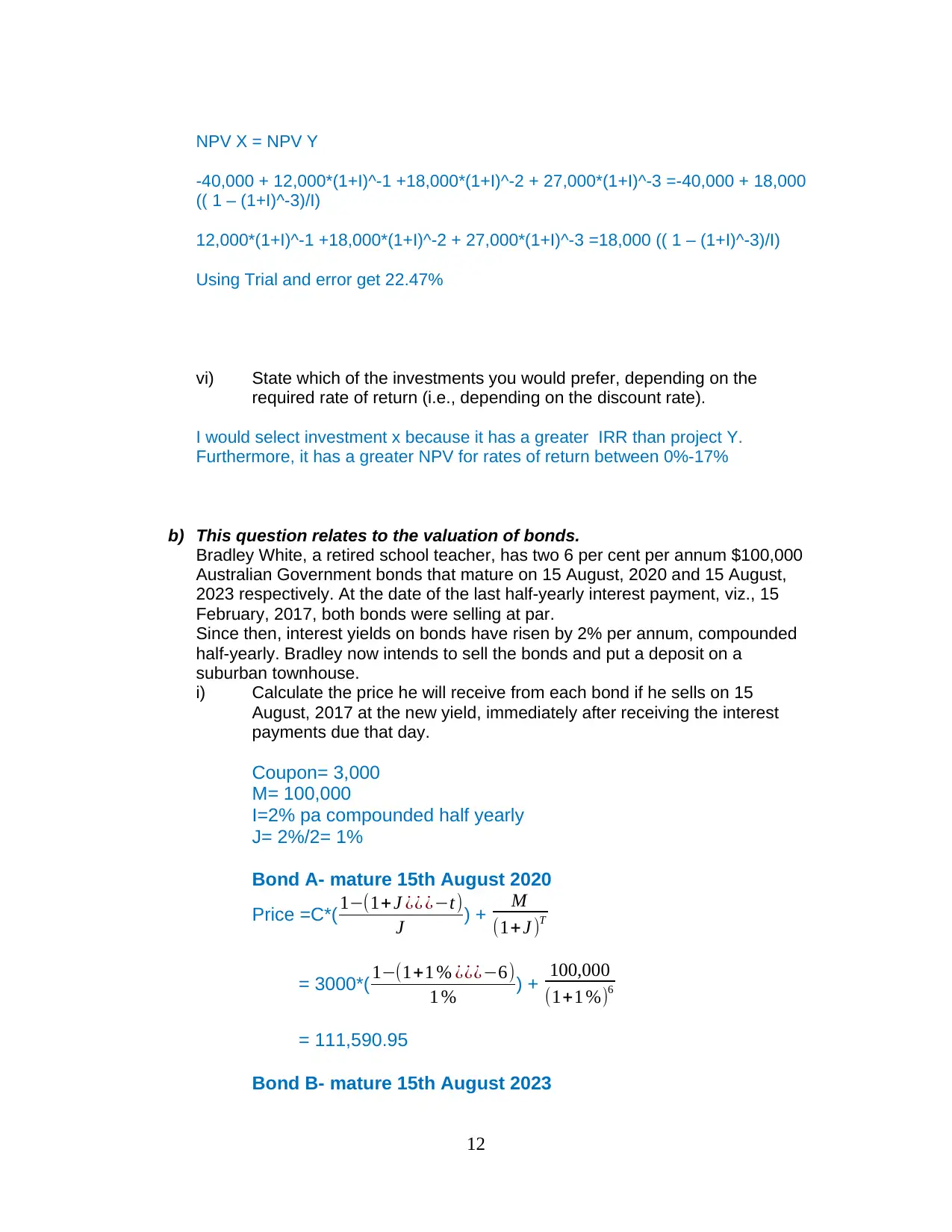
NPV X = NPV Y
-40,000 + 12,000*(1+I)^-1 +18,000*(1+I)^-2 + 27,000*(1+I)^-3 =-40,000 + 18,000
(( 1 – (1+I)^-3)/I)
12,000*(1+I)^-1 +18,000*(1+I)^-2 + 27,000*(1+I)^-3 =18,000 (( 1 – (1+I)^-3)/I)
Using Trial and error get 22.47%
vi) State which of the investments you would prefer, depending on the
required rate of return (i.e., depending on the discount rate).
I would select investment x because it has a greater IRR than project Y.
Furthermore, it has a greater NPV for rates of return between 0%-17%
b) This question relates to the valuation of bonds.
Bradley White, a retired school teacher, has two 6 per cent per annum $100,000
Australian Government bonds that mature on 15 August, 2020 and 15 August,
2023 respectively. At the date of the last half-yearly interest payment, viz., 15
February, 2017, both bonds were selling at par.
Since then, interest yields on bonds have risen by 2% per annum, compounded
half-yearly. Bradley now intends to sell the bonds and put a deposit on a
suburban townhouse.
i) Calculate the price he will receive from each bond if he sells on 15
August, 2017 at the new yield, immediately after receiving the interest
payments due that day.
Coupon= 3,000
M= 100,000
I=2% pa compounded half yearly
J= 2%/2= 1%
Bond A- mature 15th August 2020
Price =C*( 1−(1+ J ¿¿ ¿−t)
J ) + M
(1+J )T
= 3000*( 1−(1+1 % ¿¿¿−6)
1 % ) + 100,000
(1+1 %)6
= 111,590.95
Bond B- mature 15th August 2023
12
-40,000 + 12,000*(1+I)^-1 +18,000*(1+I)^-2 + 27,000*(1+I)^-3 =-40,000 + 18,000
(( 1 – (1+I)^-3)/I)
12,000*(1+I)^-1 +18,000*(1+I)^-2 + 27,000*(1+I)^-3 =18,000 (( 1 – (1+I)^-3)/I)
Using Trial and error get 22.47%
vi) State which of the investments you would prefer, depending on the
required rate of return (i.e., depending on the discount rate).
I would select investment x because it has a greater IRR than project Y.
Furthermore, it has a greater NPV for rates of return between 0%-17%
b) This question relates to the valuation of bonds.
Bradley White, a retired school teacher, has two 6 per cent per annum $100,000
Australian Government bonds that mature on 15 August, 2020 and 15 August,
2023 respectively. At the date of the last half-yearly interest payment, viz., 15
February, 2017, both bonds were selling at par.
Since then, interest yields on bonds have risen by 2% per annum, compounded
half-yearly. Bradley now intends to sell the bonds and put a deposit on a
suburban townhouse.
i) Calculate the price he will receive from each bond if he sells on 15
August, 2017 at the new yield, immediately after receiving the interest
payments due that day.
Coupon= 3,000
M= 100,000
I=2% pa compounded half yearly
J= 2%/2= 1%
Bond A- mature 15th August 2020
Price =C*( 1−(1+ J ¿¿ ¿−t)
J ) + M
(1+J )T
= 3000*( 1−(1+1 % ¿¿¿−6)
1 % ) + 100,000
(1+1 %)6
= 111,590.95
Bond B- mature 15th August 2023
12
⊘ This is a preview!⊘
Do you want full access?
Subscribe today to unlock all pages.

Trusted by 1+ million students worldwide
1 out of 17
Related Documents
Your All-in-One AI-Powered Toolkit for Academic Success.
+13062052269
info@desklib.com
Available 24*7 on WhatsApp / Email
![[object Object]](/_next/static/media/star-bottom.7253800d.svg)
Unlock your academic potential
Copyright © 2020–2025 A2Z Services. All Rights Reserved. Developed and managed by ZUCOL.




